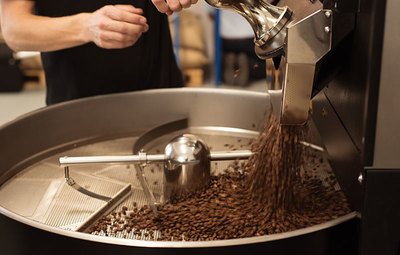
How we roast our coffee

The primary goal of roasting is to represent each coffee in such a way that the roast itself is undetectable and the best qualities of the coffee are easily accessible to the drinker. Every coffee is inherently different based on its varietal, region, terroir and processing and as such will need to be approached in different ways.
A good example of this is a Kenyan coffee compared to an Indian coffee. Kenyan coffees tend to grow at high altitude, in rich volcanic soils. The result is a very clean coffee with bright acidity and a lot of natural fruit-like sweetness. The beans are also very dense, so a typical roasting approach would be to roast the coffee fast and light. By applying a lot of heat and roasting it quickly the roaster is aiming to bring out the brightness of the coffee while allowing the natural sweetness to balance this acidity. The roaster needs to be careful not to damage the coffee with this fast, high heat approach, as this can introduce an ashy taste regardless of the level of the roast.
By comparison, our recently featured coffee, India Bibi, was roasted a fraction darker and over a minute slower. This was because the beans were less dense and more likely to be damaged by roasting it too quickly. The Indian coffee also had a lower acidity and a heavier, more pronounced caramel sweetness. By roasting it slower we aimed to bring this sweetness to the forefront.
Coffee is generally not considered roasted until it has been through an event known as “first crack”. This happens when an evaporation layer within the internal structure of the bean cracks through the external shell producing a loud cracking noise. Until this point of the roast the coffee will still taste very “green” – vegetal, grassy and hay-like. At the point of first crack the coffee is undergoing numerous Maillard and caramelizing reactions contributing to the complexity, sweetness and body of the coffee. We generally aim to discharge the coffee sometime towards the middle of first crack when the coffee has been appropriately developed to no longer display any “green” tasting notes and yet not yet have any noticeable taint of roastiness from the roaster itself.
There is a further “second crack” which is an indication of the coffee is going through a phase of dry-distillation, essentially vaporising and separating various chemical compounds and introducing carbon-like tastes to the coffee. This roast can be identified through very dark, oily beans and is usually described as either a French or Italian roast.
Roast colour, while a good indication, is not necessarily the most appropriate way to define a roast. There are many different ways in which a particular roast colour might be reached based upon the speed of the roast and how it has progressed throughout.
As you can see, many steps need to be completed with an almost scientific precision to achieve the perfect roast. But rest assured, your coffee subscription box is in good hands!


25% off
your next order
Enjoy the world's best coffee, freshly roasted & delivered to your door. Sign up to our mailing list for a welcome pack and 25% off your next Cafédirect order!

Thanks for
joining our
mailing list
A welcome pack is on its way and you get 25% off your next Cafédirect order!
